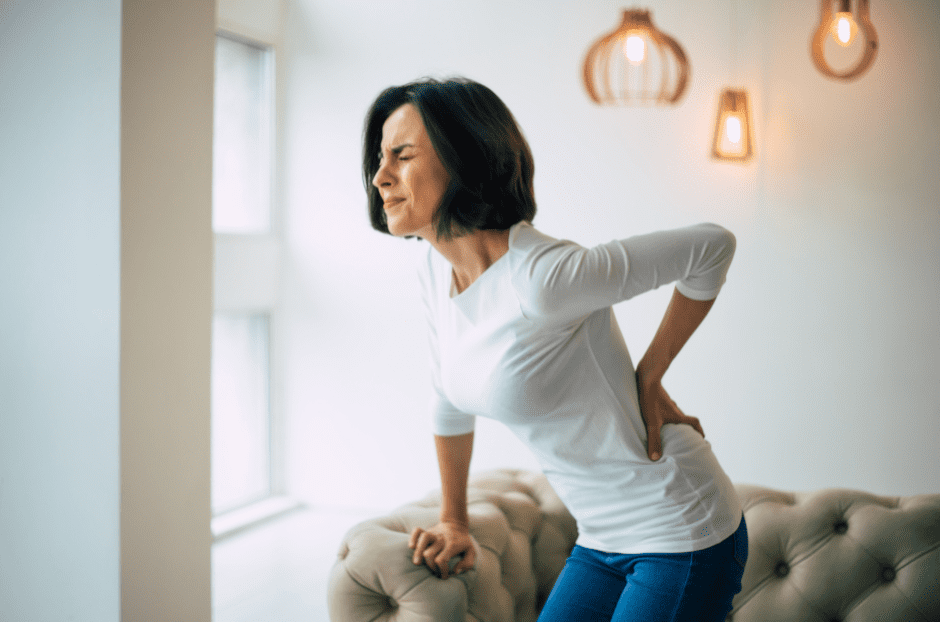
Jump to section
Lower back pain is one of the most common pains experienced by adults, with 7.5% of the global population estimated to be affected at any one time - including up to 23% of adults. From making work more challenging to causing sleep disturbances, living with low back pain is difficult, being the leading cause worldwide of years lived with disability since 1990.
Lower back pain is described as pain and discomfort located between the lower ribs and the gluteal (buttock muscles). The symptoms sought out in an assessment are the presence of pain and disability in the lower back itself. Depending on the cause of your lower back pain, you may also experience a range of other symptoms ranging from tingling or numbness, to swelling and impaired musculoskeletal movement.
Low back pain can either be defined as ‘specific’, meaning that the cause can be defined to a certain condition or problem, or ‘non-specific’, meaning that the cause is undetermined and not related to specific known causes of lower back pain. Approximately 90% of all low back pain is non-specific. Specific known causes of low back pain include:
Causes of low back pain that we often see as podiatrists also include muscle imbalances in the pelvic region, as well as limb length differences that affect muscle function.
In many conditions, there can be a link between low back and leg or foot pain that we look for as podiatrists when we carry out our assessments, diagnosis and treatment. Problems with the back that can lead to pain in the lower limbs include:
In these cases, we see the best clinical outcomes from a combined, multidisciplinary treatment approach where we partner with one or multiple other health professionals so that both your back pain and your lower limb problems are being proactively managed.
With the 9-5 office workday leading to long periods of sitting and then the pandemic forcing many people to work from home with suboptimal desk setups, more evidence is regularly being released on the impact of sitting for prolonged periods and low back pain.
Given that our bodies are designed for free and unrestricted movement, when we sit down, our muscles, bones and joints, including the spine, can start taking pressure in an unnatural way. Your spine is your body’s central support structure, providing you with much-needed mobility while remaining rigid enough to support the weight of the body. By design, the spine relies on ongoing mobility and movement to keep itself healthy and pliable.
When we sit for prolonged periods of time, like when we don’t leave our desk at work, the stress and strain on our back muscles and the spinal (intervertebral) discs increases. Our intervertebral discs act like cushioning pads between the vertebrae, with the pressure within the disc being linked to our posture as illustrated in the diagram below. This means that the way we sit, like if we slouch forwards for example, can result in almost double the stress on our spine compared to standing.

Sitting for prolonged periods can also affect our posture and muscle strength and contribute to passive back muscle stiffness, all contributing to low back pain.
Another point on low back pain that is worth a mention is its relationship to psychological stress. When we experience stress for prolonged periods or it is left unresolved, the muscle tension that the stress response produces can cause muscles in the low back to tighten, manifesting as additional strain on the body. This tight musculature can potentially lead to low back pain. Stress also heightens the body’s pain sensitivity, which can intensify the low back pain perceived. The mere presence of low back pain can also become a stressor itself, creating a pain cycle that is difficult to break.
Low back pain is diagnosed with a physical exam paired with your medical history and some testing. In order to be diagnosed with nonspecific low back pain, medical imaging and blood tests are necessary to rule out the spinal pathologies above. This testing is typically done with your GP, who may refer you to a specialist as needed.
Low back pain is typically treated in a multidisciplinary setting, with the help of your GP, physiotherapist, chiropractor or other back care specialist who will perform detailed assessments and create a tailored management plan based on the underlying cause of your pain as well as your symptoms. Here at The Feet People, while our focus is on the lower limbs, we can also look at how our assessment findings regarding your lower limb muscle strength, flexibility, range of movement, posture and function during gait may influence your lower back. In some cases, we have seen correcting a limb length difference go a long way in helping improve low back pain.
From your appointment with us, you can expect:
Low back pain is multifaceted and requires professional treatment. Ways you can reduce the strain on your lower back to help reduce your risk of pain include:
| Monday | 7:40am - 6:00pm |
| Tuesday | 7:40am - 6:00pm |
| Wednesday | 7:40am - 6:00pm |
| Thursday |
7:40am - 6:00pm |
| Friday | TEMP CLOSED |
| Saturday | CLOSED |
| Sunday | CLOSED |
Ground Floor, 344 Queen Street,
Brisbane City QLD 4000
| Monday | 7:40am - 6:00pm |
| Tuesday | 7:40am - 6:00pm |
| Wednesday | 7:40am - 6:00pm |
| Thursday |
7:40am - 6:30pm |
| Friday | 7:40am - 5:00pm |
| Saturday | 7:40am - 4:30pm |
| Sunday | CLOSED |
Newmarket Village, 114/400 Newmarket Rd, Newmarket QLD 4051